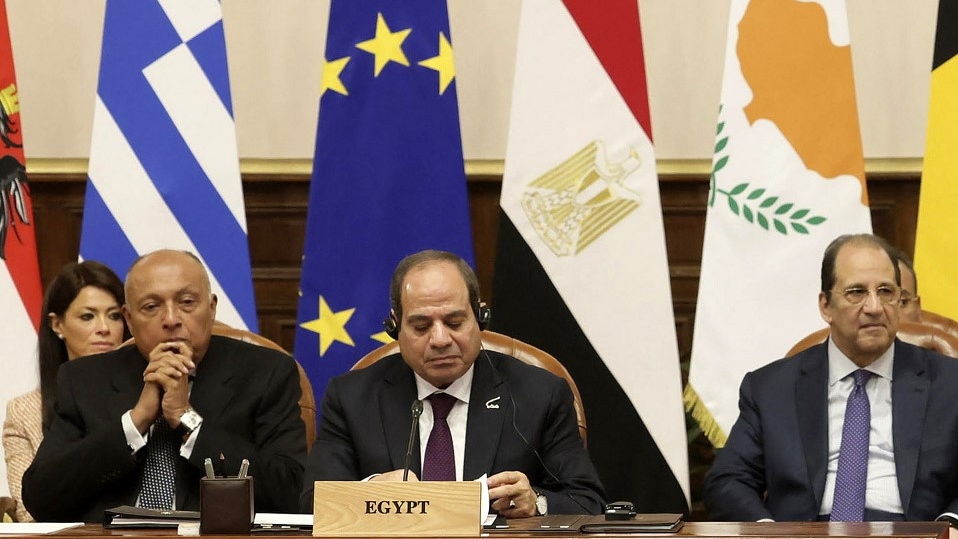What is really behind the EU deal with Egypt?

The famous adage coined for banks, "too big to fail", can be applied to countries as well.
In the hectic days of the post-2008 global financial crisis, Italy was briefly at risk of defaulting on its huge debt - but it was considered too big to fail, and received different treatment than Greece. The whole European project could have collapsed if Italy, a massive economic and manufacturing power, had defaulted.
In the MENA region, this adage perfectly fits Egypt, whose failure could have vast regional geopolitical implications that would not spare Europe.
Egypt has one of the highest GDPs in Africa, and with a population exceeding 104 million, it is also the most populous country in the region. Egypt has millions of students in higher education and an enormous labour force.
The country’s socioeconomic resilience should thus be a major concern within the complex Euro-Mediterranean theatre. Egypt’s collapse could have a destabilising regional impact akin to the 1979 Iranian Revolution.
Stay informed with MEE's newsletters
Sign up to get the latest alerts, insights and analysis, starting with Turkey Unpacked
Today, Egypt’s economic and financial situation is in significant distress. The World Bank estimates that around 30 percent of its population faces poverty; that figure is five years old and millions could soon join them. Last December inflation reached 33 percent, and it is expected to soar to 45 percent later this year.
Due to the ongoing crisis in the Red Sea, Egypt’s revenues have significantly contracted, adding further stress. Egypt already hosts an estimated nine million migrants and refugees, including four million Sudanese and 1.5 million Syrians.
Economic transformation
Nearly a decade ago, Egypt launched its ambitious Vision 2030, a comprehensive development initiative aiming to transform the country’s economy into a “balanced, knowledge-based, competitive, diversified, market economy, characterized by a stable macroeconomic environment, capable of achieving sustainable inclusive growth”.
The vision aimed to upgrade Egyptian infrastructure in the fields of transportation, energy, innovation, scientific research, transparent government, social justice, health, education, culture and urban development, among others.
The EU and its member states are now attempting to repeat with Cairo what they successfully accomplished with Ankara
Notwithstanding its dire financial situation, Egypt is moving ahead with Vision 2030’s pharaonic infrastructure projects, such as a new administrative capital, as Egyptian authorities have concluded that from an urbanistic viewpoint, the current city of Cairo cannot be managed or rearranged.
No doubt, these projects may be useful for boosting economic growth and job opportunities. But it is legitimate to question the size of certain infrastructure under development. Was it really necessary to make the new headquarters of the Egyptian armed forces an Octagon, bigger than the US Pentagon? Or to build the Iconic Tower, the tallest building in all of Africa?
The Eastern Mediterranean presents an arc of crisis from Tunisia to Syria, with Libya, Egypt, Israel-Palestine and Lebanon in the middle, where the potential for conflicts and refugee flows is quite high. Egypt remains a pivotal point in this arc.
The Egyptian government's decision to build a new capital away from Cairo could also be interpreted as a precaution to isolate and protect the ruling class from potential upheavals caused by the dire economic situation; is it possible then that President Abdel Fattah el-Sisi and the military expect another Arab Spring?
Just to put the whole issue in the proper context, it barely needs mentioning that Egypt’s collapse could have a destabilising regional impact akin to the 1979 Iranian Revolution, which would not spare Europe.
The European Union has for years been concerned with limiting migration across the Mediterranean from North Africa, signing deals with numerous countries bordering the sea for that purpose. But the EU left the long-term work of creating conditions for sustainable development in Africa to China, which has been investing massively in the continent for decades.
'Cash for migration control'
Italy, one of the countries most affected by Mediterranean refugee flows, recently unveiled its so-called Mattei Plan - named for the late head of the Eni energy firm, Enrico Mattei - in an attempt to stimulate growth opportunities in Africa, which could prevent emigration. But the Italian government has set aside just under $6bn for the plan, compared to China’s whopping $400bn investment in the continent.
A few years ago, the EU made a €3 billion ($3.3bn) deal with Turkey as an incentive for Ankara to stop the wave of refugees from war-torn Syria who were attempting to reach Europe. To a certain extent, the deal worked, and the so-called Balkan route was closed.
The EU and its member states, aware of Egypt’s difficult financial situation and the nine million migrants and refugees it is hosting, are now attempting to repeat with Cairo what they successfully accomplished with Ankara.
Earlier this month, European Commission President Ursula von der Leyen, accompanied by the leaders of Austria, Belgium, Cyprus, Greece and Italy, signed a deal in Cairo with President Sisi.
The €7.4-billion ($8bn) package of loans, grants and energy cooperation deals aim to sustain the country and prevent a possible flow of refugees. It also aims to step up Egyptian energy production to further wean Europe off Russian gas.
Temporarily leaving aside the concerns raised by many human rights groups over the EU’s “cash for migration control” approach, which risks strengthening autocratic leadership, it is worth analysing the merit of the EU-Egypt deal by looking carefully at its figures. The deal reportedly includes €5 billion in loans, €1.8 billion in investments, and €600 million in grants, a third of which is dedicated to the struggle against migration. In other words, the overwhelming part of the package is loans.
Dystopian approach
Compare what could be at stake with Egypt and the far bigger financial size of the EU commitment towards Ukraine, since the conflict has started, including the last aid package valued at €50 billion ($55bn).
Although Egypt is not at war and has not experienced the type of widespread destruction confronting Ukraine, its population is several times larger.
Are we sure that this EU package is not concealing something far more sinister about the future of Gaza and its population?
Europe is preparing for a “war economy” towards an alleged Russian threat to the EU that is still speculative. The latest troubling statements by European Council President Charles Michel and French President Emmanuel Macron speak for themselves.
The first has unequivocally urged EU member states to prepare for a war economy, while the second has not ruled out the deployment of Western troops in Ukraine. At the same time, the EU seems to be underestimating a far bigger and real threat on its southern borders.
While EU leaders continue to obsess over a purported Russian threat to Eastern Europe, Moscow’s military activity in sub-Saharan Africa is increasing, essentially displacing the French. Moscow used to have strong energy leverage over Europe through its massive energy supplies; is the Kremlin trying to gain new leverage against Europe with its new allies in resource-rich West Africa?
Last but not least, by watching the tragic situation in Gaza and the possible Israeli military operation in Rafah that could displace more than one million Palestinians, are we sure that this EU package is not concealing something far more sinister about the future of Gaza and its population?
Might the $8bn package be an attempt to bribe Egypt into accepting a “temporary” exodus of Palestinians into the Sinai, with a commitment from Cairo to keep them there? Do European leaders know something that their publics do not yet?
The views expressed in this article belong to the author and do not necessarily reflect the editorial policy of Middle East Eye.
Middle East Eye delivers independent and unrivalled coverage and analysis of the Middle East, North Africa and beyond. To learn more about republishing this content and the associated fees, please fill out this form. More about MEE can be found here.






